As a little boy, I always wanted to fly. I didn’t understand what it meant to be a pilot, just that to me, to be in the air was to be free. I grew up during the end of the Cold War, in the shadow of nuclear war with the USSR. I lived under the flight path of Moffett Field (a California Naval Air Station), and would watch the daily flights of U.S. Navy/Lockheed P-3 Orions head out to look for submarines off the Pacific coast. I remember the engine noise would rattle the windows of my bedroom morning and evening as the aircraft departed and returned.
A rocky youth coupled with my 6’-5” stature made it clear that a military career was not in the cards for me. I refocused my efforts and learned how to drive a desk in Silicon Valley’s tech industry. Somewhere in the middle of my career, my mother fell sick from cancer and, within six months, the only things that I had left was her memory and enough money to get a pilot’s license. From that first flight to today, I have been on a journey of hope.
Along the way, I’ve picked up a few pilot certificates and even an airframe and powerplant mechanic’s certificate, with inspection authorization. I also acquired a few airplanes that needed more care than their previous owners could provide. That can be like eating peanuts: Once you start, it’s hard to stop.
Also along the way, I’ve met many more people like me, who are attracted to aviation for reasons. It rarely matters what their motivation is, only that they’re serious, that they are dedicated, that they relish in the aviation learning experience. And that they don’t accept failure or defeat without a fight.
PATTERNS
Without doubt, the hardest accomplishments and the only ones that have any meaning to me are those I have achieved in aviation. I have struggled at every step, every Certificate, every rating. I have learned through failure how to succeed. I have had many people who helped me, coached me and taught me. It is through those eyes that I see the students who come to me on their own journey of hope.
I’ve had many different types of students over the years. Some were so young that they did not even qualify for a student certificate. And some are so old that their grandchildren have children.
Everyone’s path will have victories and challenges. Although no two are identical, I have noticed some recurring patterns.
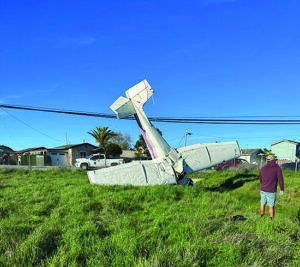
When I work with a pilot in the earlier stages of their life, their minds seem directly attached to their hands. If they can understand what must be accomplished, they can in short order perform the task.
I had an exceptional student to whom I demonstrated only one time how to land the aircraft, and from that time on, he could consistently land it with extraordinary skill. I have had students in their twilight years who struggle and struggle to even accomplish one good landing.
I further noted that those younger students, with all those kinesthetic skills, apply their knowledge to new situations, or figure out how the skills they already have can be strung together to solve an apparently different problem. They struggle with regulations, processes and how the whole puzzle fits together. They also struggle with how to find an answer on their own.
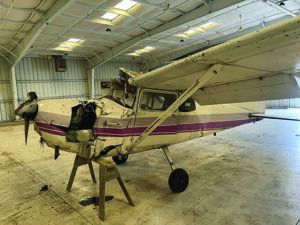
Those older students often only need to be pointed in a general direction and they can apply existing knowledge to solve a problem. They also can more easily recognize when they don’t have all the pieces and will proactively work to gather the additional information needed to complete the puzzle.
LANDING PRACTICE
One of my students was in the second category: enjoying their retirement by learning to fly. They worked hard. Studied diligently. Passed their written test and had demonstrated, to my satisfaction, the skills needed for successful landing of the aircraft. Still a student pilot, they were in the process of practicing the landings required for a private pilot certificate at their home airport.
On their last landing of the day, they came in too low, and caught some power lines running along the outer edge of the airport. This turned the forward velocity of the aircraft into vertical velocity, abruptly ending the flight short of the runway. The pilot survived with some injuries. The airplane wasn’t as fortunate.
ADEQUATE PROGRESS?
The FAA and NTSB opened an investigation of the accident. I spoke with them about my student’s progress. It turns out their previous instructor felt that they were not making adequate progress and after consultation with their peers ended the instruction relationship.
I don’t want to minimize the thoughts of the other instructors; I do believe that they at all times acted in good faith. I also believe students have different learning styles, teachers have different teaching styles and a student learns best when they mesh rather than clash.
We both felt we were a better match than the previous instructor in terms of learning and teaching styles, and my student’s progress confirmed our view of the situation.
My position has always been that if you are safe to drive a car, you should be able to operate an aircraft safely as well. Although the FAA will not issue a first class medical (used for flying around large aircraft full of the public) after the age of 65, they have no age-related restrictions for a private pilot.
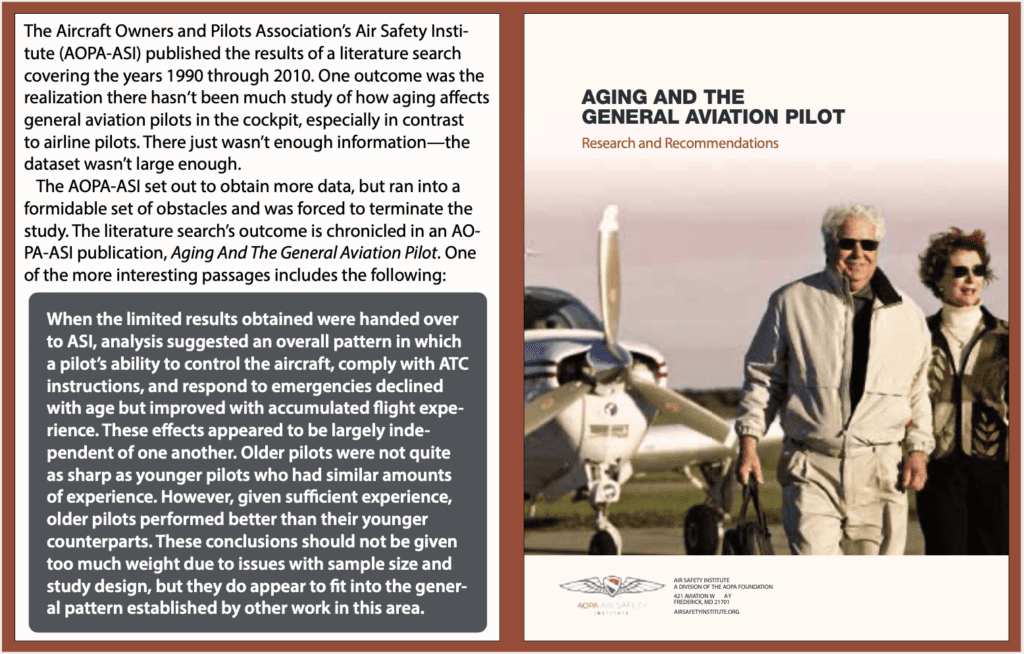
IT ALL DEPENDS
How do we decide when someone’s journey of hope is ending? One could argue that at some age you are just too old. But when? There are 25-year-olds who will never have the attention to detail needed to safely fly an aircraft. There are 75-year-olds in better health than the average 50-year-old.
I had a student with late-stage cancer who told me that he wanted to learn to fly before he died. We flew together for several months. Although he was never able to demonstrate the skill level needed to solo, he got to fly with an instructor as long as he was able to. He ended up purchasing an airplane and when he was too sick to get into the air, he would still come to the airport and polish his aircraft. It gave him a reason to get out of bed.
A different friend would tell me about his kit aircraft that he started building after his wife died. His eyes lit up with the promise of one day returning to the skies. Working on the aircraft gave him something to focus on through his grief. He died before the aircraft was completed. Both of these pilots’ journeys of hope were just as important to them and their lives as the journeys that get completed. My local airport is filled with pilots who will never become professional pilots, who will never earn a significant amount of money in aviation. But they get to take their journey of hope, and when they get to the airport, for a moment, they get to defy gravity.
A JOURNEY NAMED DESIRE
The only consistent trait I have seen among the students who earn their certificates is how much they want it. They can’t have their parents want it to be completed for them. It can’t be bought for someone or given to them. They have to want it enough to complete their journey of hope to get a pilot certificate.
And here is where those two ideas collide. When you want to fly with every fiber of your being, enough to come out to the airport lesson after lesson and to fly in a circle again and again, trying to land like a butterfly with sore feet. But you don’t meet the stereotype of a younger male looking to start his journey toward flying for the airlines.
Should I give up on the student? Are they too old? Did age actually have anything to do with the crash? Or was it a combination of a student pilot making a mistake, and bad luck to make that error where it was made?
I would never permit a student to fly if I had any doubt that they could operate the airplane safely. But how should we as a community evaluate such risk? Is it one and done for all pilots regardless of time flying? Age? Skills evaluation? Some combination?
It would be easier to only approve those students with the faster reflexes of youth. Except doing the wrong thing faster isn’t safer than doing the right thing slower. I am much more concerned with the 18-year-old kid who just earned their ticket taking a load of their friends to South Lake Tahoe for a ski weekend than a retiree taking their grandkids for a sightseeing flight.
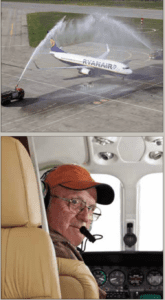
Anyone who’s spent much time around career pilots and professional aviation likely is familiar with a water cannon salute. It’s a ceremony that can be expected to help welcome a new aircraft type or carrier to an airport, or to say farewell to one retiring. It’s also done in the maritime industries, with ships. At airports, it’s typically done as shown at right with this RyanAir Boeing 737.
In an earlier life, I was tasked with setting up such an event, honoring a senior pilot flying his last flight. Approaching the task certain in the belief I wouldn’t be able to find someone at Nearby International Airport who knew what I was talking about, I called the facility’s public relations shop and asked if anyone knew what I was talking about.
“Oh, sure,” came the reply. “We do these all the time. All I need is to coordinate with the CFR people and ask Ground to route them to a certain pad when they land. What aircraft type, carrier, flight and time?” It was that easy, and I came out looking good
But that’s not the point. Instead, the point is that captain knew he was retiring. He was lucky—he knew this was his last flight, at least as an airline captain. Many of us, on the other hand, don’t know when we’ll fly our last flight. In part that’s because of the casual nature of general aviation—there’s no one looking over our shoulder as we hit 65. It’s also in part thanks to the aging process itself and its penchant for sneaking up on us until it’s too late to do something to mark the occasion.
There are two kind of pilots: Those who will know ahead of time it’s their last flight and those who won’t. The former may warrant the kind of commemoration shown here. The latter may also, but that pilot won’t receive this kind of attention, simply because no one else will know, either. But more important, will they realize it when their journey of hope is fulfilled and they can “retire,” or will they fail to close that circle, without knowing until it’s too late for ceremony that they’ve flown their last flight? — J.B.
EARNED THE RESPONSIBILITY
In my mind, if you can demonstrate that you can competently and consistently operate the aircraft and that you meet the standards laid out in the regulations, you have earned the right to take on the responsibility of flying you and your passengers.
There is risk in this, just like there is risk in the drive to the airport. And just like in those car rides, there will be people who will hurt themselves because of the choices they make. This is the informed risk we take for this journey of hope. It’s not a journey everyone can complete, but that doesn’t mean you shouldn’t start it.
J.R. Warmkessel holds FAA flight, instrument and multi-engine instructor certificates, and is an A&P/IA. He’s also an aviation podcaster and IT professional living in the San Francisco area.

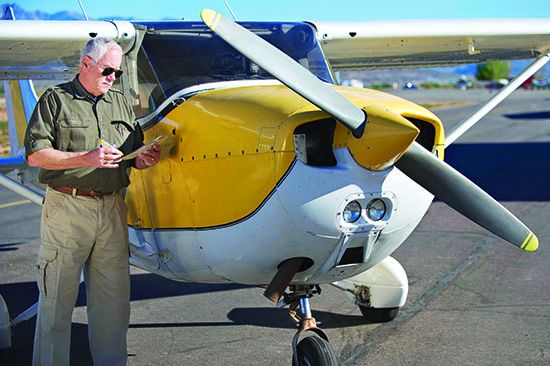



Such a great heart-warming perspective of the aviation journey, thank you
Mr. Warmkessel is incorrect when he states that the FAA will not issue a First Class medical certificate after the age of 65. There is no age limit for any class of medical. I quote from the FAA’s website:
Medical Certification. There is no age restriction or aviation experience requirement for medical certification. Any applicant who qualifies medically may be issued a Medical Certificate regardless of age.
The AME may issue any class of medical certificate without regard to age to any applicant who meets the appropriate medical standards.
There is a maximum age requirement for certain air carrier pilots. This is an operational requirement, not a medical certification requirement.
Great article. I have lost my ability to qualify for an FAA medical certificate due to my implant of a defibrillator. I was a civilian flight instructor while in college, a Navy jet flight instructor, and an A6 pilot. I renewed all of my flight instructor ratings after retiring from Navy and flew as an instructor for Civil Air Patrol and Part 61 clients. I was awarded the Wright Brothers “Master Pilot” Award for fifty years of dedicated service in aviation safety. God I miss flying as pilot in command with an FAA medical.
I know that feeling.
Over fifty years flying and associated to multiple experiences in the air, from Hang Gliders to Corporate Aviation Turbo Props, Jets and Choppers, a lifetime over the ground, I can help if still when outside look up above the sky and make a quick evaluation of conditions, hiding a longing to be there..
Holder of FAA all PIC ratings and past owner of a Maule, a C-182 and a C-182 RG, enjoy sharing stories and advice, while checking the grapevine.